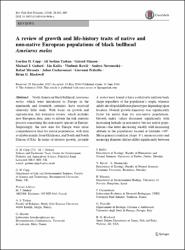A review of growth and life-history traits of native and non-native European populations of black bullhead Ameiurus melas

Göster/
Tarih
2016Yazar
Copp, Gordon H.Tarkan, Ali Serhan
Masson, Gerard
Godard, Michael J.
Kosco, Jan
Kovac, Vladimir
Blackwell, Brian G.
Üst veri
Tüm öğe kaydını gösterÖzet
North American black bullhead, Ameiurus melas, which were introduced to Europe in the nineteenth and twentieth centuries, have received relatively little study. With focus on growth and reproduction, this extensive review, which includes new European data, aims to inform the risk analysis process concerning this non-native species in Europe. Surprisingly, the new data for Europe were more comprehensive than for native populations, with data available mainly from Oklahoma, and North and South Dakota (USA). In terms of relative growth, juvenile A. melas were found to have a relatively uniform body shape regardless of the population's origin, whereas adults developed different phenotypes depending upon location. Overall growth trajectory was significantly faster for native than for non-native populations. Growth index values decreased significantly with increasing latitude in non-native but not native populations-the latter decreasing weakly with increasing altitude in the populations located at latitudes <40 degrees. Mean general condition (slope ' b'), mean sex ratio and mean egg diameter did not differ significantly between native and non-native populations. Absolute fecundity was slightly (but not significantly) higher in non-native than native populations. GSI data, which were very scarce for native populations, suggest gonad production may be slightly higher in native than in non-native populations. Precise data on age at maturity (AaM) are lacking for the native range, where 2-5 years is reported. Whereas, in the introduced range the greatest AaM was 3.5 years, and AaM decreases with increasing juvenile growth (TL at age 3). The populations with fastest juvenile growth tended to be from warmer water bodies where they are considered to be invasive. The great growth and life-history plasticity of black bullhead affords the species great potential to invade and establish viable populations in new areas.

















